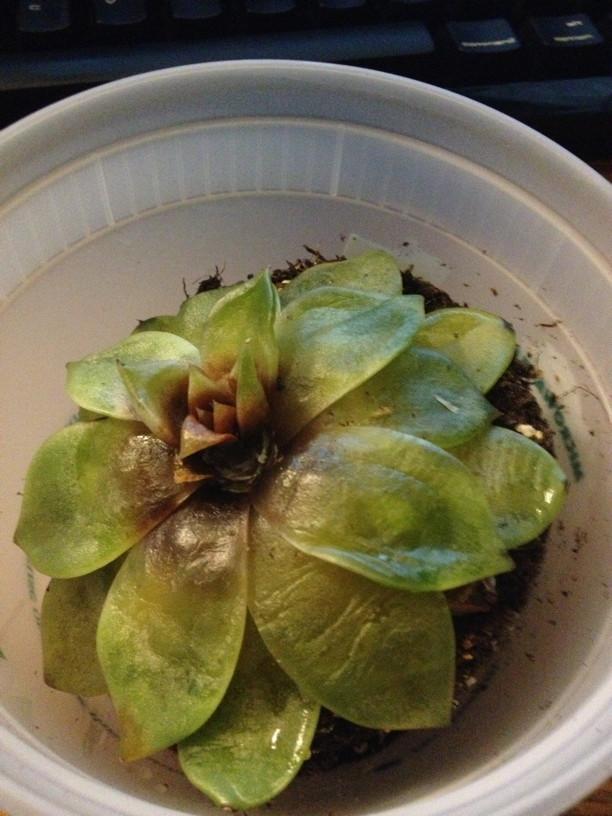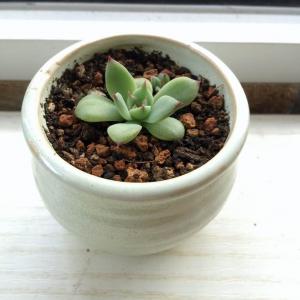文章
Dummer. ゛☀
2017年09月22日

Succulents are hardy plants that add a striking appearance to any garden or home. Performing best in U.S. Department of Agriculture hardiness zones 3 through 9, succulents are good plants for the novice and expert gardener alike, as they require little attention. Because succulents are desert plants, they should be watered sparingly. Succulents are typically not susceptible to insect or pest infestation, but overwatering can lead to root or stem rot, a preventable and easily fixable disease. Succulents with signs of root or stem rot should be treated immediately.
1. Check the plant for infected areas. These typically appear as dark brown to black spots or areas on the low part of the plant. Other signs of root or stem rot include puckered flesh with a dark tint around the infected area.
2. Stop watering a plant with rot. Remove the plant from its pot. Remove the soil mixture and clean out the pot thoroughly to ensure no remnants of the fungus are left.
3. Cut the infected black stem from the plant with a garden knife. Let the healthy portion of the plant dry naturally for several hours, keeping the succulent out of direct sunlight during this process. If other areas of the plant are showing minimal signs of rot, keep an eye on the plant. Succulents can recover from stem rot if properly watered and placed in a warm, dry location.
4. Using the cleaned out pot or a fresh one, combine equal parts soil, coarse sand and peat moss. Don’t reuse any of the materials used with the infected plant.
5. Pour roughly 2 inches (5 cm) of the mixture into the pot. Place the newly doctored succulent into the pot with the roots lying on top of the soil. Fill the pot with the soil mixture until it reaches the base of the stems. Firmly pat the soil around the plant.
6. Place the succulent in a brightly lit spot with warm temperatures. Succulents prefer dry climates, so don’t place the plant in a humid location.
7. Water the plant with just enough water to moisten the soil one week after repotting. After the soil has completely dried out, you can water more thoroughly.
Tip
Succulents grow best in well-drained soils that provide a high water-holding capacity. Planting succulents in a clay pot with a drainage hole ensures there is no sitting water and that the soil dries out between waterings. Succulents are dormant during the winter and should only be watered lightly at this time.

1. Check the plant for infected areas. These typically appear as dark brown to black spots or areas on the low part of the plant. Other signs of root or stem rot include puckered flesh with a dark tint around the infected area.
2. Stop watering a plant with rot. Remove the plant from its pot. Remove the soil mixture and clean out the pot thoroughly to ensure no remnants of the fungus are left.

3. Cut the infected black stem from the plant with a garden knife. Let the healthy portion of the plant dry naturally for several hours, keeping the succulent out of direct sunlight during this process. If other areas of the plant are showing minimal signs of rot, keep an eye on the plant. Succulents can recover from stem rot if properly watered and placed in a warm, dry location.
4. Using the cleaned out pot or a fresh one, combine equal parts soil, coarse sand and peat moss. Don’t reuse any of the materials used with the infected plant.

5. Pour roughly 2 inches (5 cm) of the mixture into the pot. Place the newly doctored succulent into the pot with the roots lying on top of the soil. Fill the pot with the soil mixture until it reaches the base of the stems. Firmly pat the soil around the plant.
6. Place the succulent in a brightly lit spot with warm temperatures. Succulents prefer dry climates, so don’t place the plant in a humid location.
7. Water the plant with just enough water to moisten the soil one week after repotting. After the soil has completely dried out, you can water more thoroughly.

Tip
Succulents grow best in well-drained soils that provide a high water-holding capacity. Planting succulents in a clay pot with a drainage hole ensures there is no sitting water and that the soil dries out between waterings. Succulents are dormant during the winter and should only be watered lightly at this time.
0
0
文章
Dummer. ゛☀
2017年09月22日

Originally from Africa, the Jade Tree (Crassula ovata) is a fleshy, softly woody shrub or small tree up to 10 feet (3 m). The Jade Tree has a thick trunk and a fine branch structure with thick oval green succulent leaves. During autumn sometimes small white flowers appear, but only when the tree has experienced droughts in the season. The bark is green and soft when young, becoming red-brown when it ages.
Specific Bonsai Care Guidelines for the Jade Tree
Position: The Jade Tree is considered an indoor tree in most temperate zones, although it can be grown outdoors in full sun (and sufficiently high temperatures). Keep temperatures above 41ºF (5 ºC) at all times. It needs lots of light or even full sun.
Watering: Jade Trees can hold large amounts of water inside their leaves. Water sparsely and allow the plant to dry out a little bit between watering. During winter time watering can be as seldom as once every three weeks. The Jade Tree is not as particular about over-watering as most other succulents.
Feeding: Once a month during the growth season (spring-autumn).
Pruning: As a succulent, water is contained its trunk and branches; they tend to bend from their weight. Jades respond well to pruning, which should be done regularly to force the tree to grow branches also lower on its trunk. Do not use cut-paste though, as this might lead to rotting.
Repotting: Repot the three every second year in spring, using a very well-draining soil mixture.
Propagation: Easy to propagate using cuttings during the summer.

Specific Bonsai Care Guidelines for the Jade Tree
Position: The Jade Tree is considered an indoor tree in most temperate zones, although it can be grown outdoors in full sun (and sufficiently high temperatures). Keep temperatures above 41ºF (5 ºC) at all times. It needs lots of light or even full sun.

Watering: Jade Trees can hold large amounts of water inside their leaves. Water sparsely and allow the plant to dry out a little bit between watering. During winter time watering can be as seldom as once every three weeks. The Jade Tree is not as particular about over-watering as most other succulents.

Feeding: Once a month during the growth season (spring-autumn).
Pruning: As a succulent, water is contained its trunk and branches; they tend to bend from their weight. Jades respond well to pruning, which should be done regularly to force the tree to grow branches also lower on its trunk. Do not use cut-paste though, as this might lead to rotting.

Repotting: Repot the three every second year in spring, using a very well-draining soil mixture.
Propagation: Easy to propagate using cuttings during the summer.
0
0
文章
贾宗伟
2017年09月22日

主要的三大改变:
1.叶子的退化(lossofleaves)
2.可储存水份的多肉组织(water-storingsucculenttissues)
3.刺的形成(formationofspines)
次要的改变:
1.延迟的"树皮组织"生成(delayedbarkformation)
2.松散的外皮细胞(looseningofthecortexcells)
3.具弹性的脊(flexibleribs)
4.皮质维管束(corticalbundles)
1.叶子的退化(lossofleaves)
虽然大面积的叶表面可以大量的行光合作用来制造养分,但也同样地易使水份蒸散掉,所以这对生长在水份相对少的区域的仙人掌祖先而言是相当不利的。所以经数百万年的演化,仙人掌才演化成现今只有一些小叶子(如某些Opuntia属)甚至完全没叶子(绝大部份的仙人掌)。
nirwa推想,由此可见仙人掌祖先应该不是一开始就生长在极端的环境的,在Thecactusodyssey第一章的最後一个部份(GeologicalHistoryofsouthamericasettingthestageforcactusevolution)有提到,也是持相同的看法。
作者说,为何仙人掌大都产於南美洲?而北美洲的品种比较少?这可能是仙人掌祖先最早是住在南美洲的丛林,经数百万年的传播与演化才变成目前我们所看到的分布状态。不过,这也跟最早的南美洲和北美洲是同一块大陆尔後再漂移(drifting)开来以及和後来一些山脉的形成或地形地貌的改变也有很大的关系。
2.可储存水份的多肉组织(water-storingsucculenttissues)
这个是很容易了解的。有些地区一年只下一次或两次雨,在秘鲁(Peru)的南部以及智利(Chile)的北部的荒漠地区(bone-drydeserts)甚至每5~10年才下一场雨。它们必须在这些宝贵被土壤吸收或蒸散掉前,尽可能吸水(这也是部份仙人掌具大面积却很浅层的根系的原因)并靠这些水熬到下一次的降雨。
仙人掌祖先就慢慢演化出"肥肥的细胞"以及很多"肥肥的细胞"来因应。这些细胞大都聚集在茎的外层(即cortex;皮层)以及最里面的组织(即pith;髓部)。所以具更肥厚的多肉组织是仙人掌最具特色的特徵之一。
在一般印象中,"在沙漠中快渴死的人可以找到仙人掌就可活命"是这样没错,可是可能没办法把仙人掌剖开然後就有水泯泯而出事实应该不是这样,仙人掌的茎是有储存水份没错,但那个快渴死的人可能要用"嚼"的或"打成汁"才可从仙人掌补充水份,为什麽?因为水份都储存在细胞中而非组织间隙中…而且味道可能不会很好,看过"CAM-仙人掌与多肉植物的光合作用"了吗?
3.刺的形成(formationofspines)
刺的形成除了可减少水份的蒸发外,也可保护植株来避免其他动物的啃食。腋窝的芽苞或叶子因此可受到保护,不过有些沙漠地区的动物也演化出对付仙人掌剌的方法。有些鸟类也利用仙人掌,在柱形仙人掌(如弁庆柱)上打洞,就在上面筑巢养育下一代,鸟类在仙人掌根部会排遗,也替仙人掌加一些肥料,也算是一种共生现象。
1.叶子的退化(lossofleaves)
2.可储存水份的多肉组织(water-storingsucculenttissues)
3.刺的形成(formationofspines)
次要的改变:
1.延迟的"树皮组织"生成(delayedbarkformation)
2.松散的外皮细胞(looseningofthecortexcells)
3.具弹性的脊(flexibleribs)
4.皮质维管束(corticalbundles)
1.叶子的退化(lossofleaves)
虽然大面积的叶表面可以大量的行光合作用来制造养分,但也同样地易使水份蒸散掉,所以这对生长在水份相对少的区域的仙人掌祖先而言是相当不利的。所以经数百万年的演化,仙人掌才演化成现今只有一些小叶子(如某些Opuntia属)甚至完全没叶子(绝大部份的仙人掌)。
nirwa推想,由此可见仙人掌祖先应该不是一开始就生长在极端的环境的,在Thecactusodyssey第一章的最後一个部份(GeologicalHistoryofsouthamericasettingthestageforcactusevolution)有提到,也是持相同的看法。
作者说,为何仙人掌大都产於南美洲?而北美洲的品种比较少?这可能是仙人掌祖先最早是住在南美洲的丛林,经数百万年的传播与演化才变成目前我们所看到的分布状态。不过,这也跟最早的南美洲和北美洲是同一块大陆尔後再漂移(drifting)开来以及和後来一些山脉的形成或地形地貌的改变也有很大的关系。
2.可储存水份的多肉组织(water-storingsucculenttissues)
这个是很容易了解的。有些地区一年只下一次或两次雨,在秘鲁(Peru)的南部以及智利(Chile)的北部的荒漠地区(bone-drydeserts)甚至每5~10年才下一场雨。它们必须在这些宝贵被土壤吸收或蒸散掉前,尽可能吸水(这也是部份仙人掌具大面积却很浅层的根系的原因)并靠这些水熬到下一次的降雨。
仙人掌祖先就慢慢演化出"肥肥的细胞"以及很多"肥肥的细胞"来因应。这些细胞大都聚集在茎的外层(即cortex;皮层)以及最里面的组织(即pith;髓部)。所以具更肥厚的多肉组织是仙人掌最具特色的特徵之一。
在一般印象中,"在沙漠中快渴死的人可以找到仙人掌就可活命"是这样没错,可是可能没办法把仙人掌剖开然後就有水泯泯而出事实应该不是这样,仙人掌的茎是有储存水份没错,但那个快渴死的人可能要用"嚼"的或"打成汁"才可从仙人掌补充水份,为什麽?因为水份都储存在细胞中而非组织间隙中…而且味道可能不会很好,看过"CAM-仙人掌与多肉植物的光合作用"了吗?
3.刺的形成(formationofspines)
刺的形成除了可减少水份的蒸发外,也可保护植株来避免其他动物的啃食。腋窝的芽苞或叶子因此可受到保护,不过有些沙漠地区的动物也演化出对付仙人掌剌的方法。有些鸟类也利用仙人掌,在柱形仙人掌(如弁庆柱)上打洞,就在上面筑巢养育下一代,鸟类在仙人掌根部会排遗,也替仙人掌加一些肥料,也算是一种共生现象。
0
0
文章
Miss Chen
2017年09月22日

La acerola, Malpighia glabra, es una planta perenne perteneciente a la familia de las Malpighiaceae y es nativa de América Central y del Sur. Conocida por su fruto del mismo nombre es un arbusto que alcanza como mucho unos 3 metros de altura y está provisto de un robusto sistema radicular y una parte aérea densamente ramificada.
Las ramas jóvenes están recubiertas de una fina pelusilla y tienen la corteza verde. Las ramas de más edad, sin embargo, tienen la corteza agrietada y de color marrón. La hojas, coriáceas y de color verde oscuro (de color rojizo en la etapa juvenil), son alargadas y ovaladas con los márgenes ligeramente ondulados.

Durante el periodo de floración, a finales de primavera o comienzos del verano, en la base de las axilas de las hojas brotan racimos de flores con la corola de cinco pétalos y de color rosa que rodean a los largos estambres amarillos. Es una floración muy parecida a la de los cerezos.

Las bayas de la acerola reciben el mismo nombre y tienen un gran parecido, en su exterior y su distribución, con las cerezas. En cambio el interior recuerda más al de las mandarinas por su forma segmentada, son jugosas y ricas en vitamina C. En su interior encontramos también las semillas que son pequeñas y de color negro.

La acerola soporta bajas temperaturas pero necesita una larga exposición al sol. Prefiere los suelos ricos en materia orgánica, sueltos, bien drenados y con un pH ligeramente ácido. Durante los periodos de sequía hay que regarla regularmente. También precisa de un buen abonado con estiércol, una vez al año, y algún fertilizante de liberación lenta que contenga nitrógeno, potasio y fósforo.

La acerola se reproduce por semillas, en las zonas lluviosas se puede sembrar durante todo el año y en las zonas más secas esperaremos al otoño. Este arbusto necesita una poda anual para quitar las ramas secas, rebajar el exceso de ramas en la parte central y acortar las exteriores que hayan crecido demasiado. La recolección de las acerolas se realiza antes de que maduren del todo, pierden muchas propiedades, cuando todavía están un poco verdes la concentración de vitamina C es mayor. Dicha recolección debe realizarse en las horas más frescas del día. Los frutos se conservarán en lugares frescos y secos y extendidos para que no se dañen.
Las ramas jóvenes están recubiertas de una fina pelusilla y tienen la corteza verde. Las ramas de más edad, sin embargo, tienen la corteza agrietada y de color marrón. La hojas, coriáceas y de color verde oscuro (de color rojizo en la etapa juvenil), son alargadas y ovaladas con los márgenes ligeramente ondulados.

Durante el periodo de floración, a finales de primavera o comienzos del verano, en la base de las axilas de las hojas brotan racimos de flores con la corola de cinco pétalos y de color rosa que rodean a los largos estambres amarillos. Es una floración muy parecida a la de los cerezos.

Las bayas de la acerola reciben el mismo nombre y tienen un gran parecido, en su exterior y su distribución, con las cerezas. En cambio el interior recuerda más al de las mandarinas por su forma segmentada, son jugosas y ricas en vitamina C. En su interior encontramos también las semillas que son pequeñas y de color negro.

La acerola soporta bajas temperaturas pero necesita una larga exposición al sol. Prefiere los suelos ricos en materia orgánica, sueltos, bien drenados y con un pH ligeramente ácido. Durante los periodos de sequía hay que regarla regularmente. También precisa de un buen abonado con estiércol, una vez al año, y algún fertilizante de liberación lenta que contenga nitrógeno, potasio y fósforo.

La acerola se reproduce por semillas, en las zonas lluviosas se puede sembrar durante todo el año y en las zonas más secas esperaremos al otoño. Este arbusto necesita una poda anual para quitar las ramas secas, rebajar el exceso de ramas en la parte central y acortar las exteriores que hayan crecido demasiado. La recolección de las acerolas se realiza antes de que maduren del todo, pierden muchas propiedades, cuando todavía están un poco verdes la concentración de vitamina C es mayor. Dicha recolección debe realizarse en las horas más frescas del día. Los frutos se conservarán en lugares frescos y secos y extendidos para que no se dañen.
0
0
文章
玲儿
2017年09月21日

センペルビウム(センペルビブム)の育て方・栽培方法
育て方のポイント
栽培環境・日当たり・置き場
春秋生育型の多肉植物として栽培します。3月から6月ごろの春から初夏までと、9月から11月の秋に生育期し、その間の暑い夏期と寒い冬期には休眠します。
全般に耐寒性は強く、強い霜に当たっても傷むことはありません。その一方高温多湿には弱いため、梅雨から夏にかけては雨の当たらない、風通しのよい半日陰になる場所で夏越しをさせます。
真夏以外の時期は戸外の日当たりのよい場所で管理し、雨に当ててもかまいません。晩秋に気温が下がってくると紅葉し始め、冬を越して春に暖かくなってくると紅葉色がさめ、生育期の美しい発色を見せてくれます。
庭植えにする場合は水はけがよく、夏場に半日陰になる場所がよいでしょう。

水やり
春と秋の生育期には用土の表面が乾いたらたっぷりと与えます。梅雨明けから夏の休眠期に用土が湿りすぎていると根腐れを起こすことがあるので水やりは控え、雨も当てないようにします。冬の休眠期は戸外で雨ざらしになってもかまいません。
肥料
春と秋の生育期には緩効性化成肥料か液体肥料を少量施します。

病気と害虫
病気:問題となる病気は特にありません。
害虫:カイガラムシ、アブラムシ、ネジラミ
茎や葉にカイガラムシやアブラムシ、根にネジラミ(サボテンネコナカイガラムシ)が発生することがあります。
用土(鉢植え)
水はけのよい用土を用います。鹿沼土小粒2、赤玉土小粒2、ピートモス2、川砂2、くん炭2などの配合土がよいでしょう。
植えつけ、 植え替え
植え替えは2~3年に1回行います。生育期ならいつでもできますが、生育期の直前か初期が適期です。このときに群生している株は株分け、茎が伸びてしまった株は剪定やさし木をしてもよいでしょう。

ふやし方
株分け、さし芽、タネまきでふやします。適期はいずれも3月から5月、9月から10月です。
株分け:群生している株は、植え替え時に株分けをしてもよいでしょう。
さし芽:伸びてしまったランナーの先の子株を剪定し、切った芽でさし木ができます。
タネまき:原種は、タネをまいてふやすこともできます。

主な作業
花茎の整理:春ごろから不定期に花茎を伸ばしますが、花を咲かせたロゼットは枯れてしまいます。花茎を早めに整理して、子株の生育を促しましょう。
育て方のポイント
栽培環境・日当たり・置き場
春秋生育型の多肉植物として栽培します。3月から6月ごろの春から初夏までと、9月から11月の秋に生育期し、その間の暑い夏期と寒い冬期には休眠します。
全般に耐寒性は強く、強い霜に当たっても傷むことはありません。その一方高温多湿には弱いため、梅雨から夏にかけては雨の当たらない、風通しのよい半日陰になる場所で夏越しをさせます。
真夏以外の時期は戸外の日当たりのよい場所で管理し、雨に当ててもかまいません。晩秋に気温が下がってくると紅葉し始め、冬を越して春に暖かくなってくると紅葉色がさめ、生育期の美しい発色を見せてくれます。
庭植えにする場合は水はけがよく、夏場に半日陰になる場所がよいでしょう。

水やり
春と秋の生育期には用土の表面が乾いたらたっぷりと与えます。梅雨明けから夏の休眠期に用土が湿りすぎていると根腐れを起こすことがあるので水やりは控え、雨も当てないようにします。冬の休眠期は戸外で雨ざらしになってもかまいません。
肥料
春と秋の生育期には緩効性化成肥料か液体肥料を少量施します。

病気と害虫
病気:問題となる病気は特にありません。
害虫:カイガラムシ、アブラムシ、ネジラミ
茎や葉にカイガラムシやアブラムシ、根にネジラミ(サボテンネコナカイガラムシ)が発生することがあります。
用土(鉢植え)
水はけのよい用土を用います。鹿沼土小粒2、赤玉土小粒2、ピートモス2、川砂2、くん炭2などの配合土がよいでしょう。
植えつけ、 植え替え
植え替えは2~3年に1回行います。生育期ならいつでもできますが、生育期の直前か初期が適期です。このときに群生している株は株分け、茎が伸びてしまった株は剪定やさし木をしてもよいでしょう。

ふやし方
株分け、さし芽、タネまきでふやします。適期はいずれも3月から5月、9月から10月です。
株分け:群生している株は、植え替え時に株分けをしてもよいでしょう。
さし芽:伸びてしまったランナーの先の子株を剪定し、切った芽でさし木ができます。
タネまき:原種は、タネをまいてふやすこともできます。

主な作業
花茎の整理:春ごろから不定期に花茎を伸ばしますが、花を咲かせたロゼットは枯れてしまいます。花茎を早めに整理して、子株の生育を促しましょう。
0
0
文章
Miss Chen
2017年09月21日

El plumerillo rosado o manduruvá, Calliandra brevipes, es un arbusto globoide perteneciente a la familia de las Fabaceae y originario de Brasil, norte de Argentina y Uruguay. Es un arbusto muy ramificado que puede alcanzar como mucho 3 metros de altura en las mejores condiciones. Veamos pues alguna cosilla referente al cultivo del plumerillo rosado.
Sus hojas son compuestas, bipinnadas y opuestas. Son pequeñas y de color verde oscuro. Las flores crecen en el extremo de un tallo y tienen forma de nube de polvo. Forman capítulos densos, con estambres de color rosa aunque también pueden ser de color blanco y morado según las variedades. La inflorescencia está compuesta de estambres muy finos unidos en una copa redondeada y fragante.

Su floración se produce en primavera y verano. Las flores atraen a colibríes y mariposas. En jardinería se utiliza a menudo como planta aislada pero también formando conjuntos y cómo seto, podado o no.
El plumerillo rosado es una planta tolerante a las heladas y el frío. Se cultiva a pleno sol, no es muy exigente con el suelo, pero gozará con un suelo fértil enriquecido con materia orgánica y regado con regularidad. Su hábitat natural se encuentra en zonas húmedas y riberas.

Es una planta rústica que no necesita fertilizantes, salvo para garantizar mayores floraciones, en dicho caso realizar aportes anuales con estiércol bien curado y harina de huesos o fertilizante NPK 4-14-8. Acepta muy bien las podas típicas de jardinería y es imprescindible la de limpieza para quitarle la madera muerta. Se multiplica por esquejes y sobre todo y con mayor facilidad, por semillas.
Sus hojas son compuestas, bipinnadas y opuestas. Son pequeñas y de color verde oscuro. Las flores crecen en el extremo de un tallo y tienen forma de nube de polvo. Forman capítulos densos, con estambres de color rosa aunque también pueden ser de color blanco y morado según las variedades. La inflorescencia está compuesta de estambres muy finos unidos en una copa redondeada y fragante.

Su floración se produce en primavera y verano. Las flores atraen a colibríes y mariposas. En jardinería se utiliza a menudo como planta aislada pero también formando conjuntos y cómo seto, podado o no.
El plumerillo rosado es una planta tolerante a las heladas y el frío. Se cultiva a pleno sol, no es muy exigente con el suelo, pero gozará con un suelo fértil enriquecido con materia orgánica y regado con regularidad. Su hábitat natural se encuentra en zonas húmedas y riberas.

Es una planta rústica que no necesita fertilizantes, salvo para garantizar mayores floraciones, en dicho caso realizar aportes anuales con estiércol bien curado y harina de huesos o fertilizante NPK 4-14-8. Acepta muy bien las podas típicas de jardinería y es imprescindible la de limpieza para quitarle la madera muerta. Se multiplica por esquejes y sobre todo y con mayor facilidad, por semillas.
0
0
文章
Miss Chen
2017年09月21日

La clusia es un arbusto o árbol pequeño que puede llegar a los 6 metros de altura si no se poda. Aunque lo habitual es que alcance entre 1 y 3 metros de altura. Su follaje es muy ornamental, con hojas rígidas y brillantes en forma de gotas. Tiene una característica interesante: es capaz de absorber el dióxido de carbono por la noche, por lo que la fotosíntesis es más eficiente y se encuentra más protegida contra la deshidratación. Las flores son pequeñas y de color blanco, es una especie dioica, es decir, tiene plantas masculinas y femeninas. La floración se produce en primavera y verano. Sus pequeños frutos atraen a las aves.
Al ser originaria de la América tropical, sobre todo de Brasil, es una planta que precisa temperaturas cálidas y mucha luz. Es una planta perenne que puede florecer durante todo el año, aunque como hemos dicho lo hace sobre todo en primavera y verano. Lógicamente esa floración durante todo el año dependerá del clima donde la cultivemos.

Tiene un amplio uso en jardinería para coberturas y setos, especialmente en la costa, donde otras plantas tienen dificultades para adaptarse. También se puede plantar en macetas en terrazas o interior. También se suele cultivar de forma individual o formando pequeños agrupamientos. Necesita un suelo rico y bien drenado así como una buena exposición al sol.

El riego debe ser regular, al menos una vez a la semana. En primavera y verano podemos aumentar la periodicidad a dos veces por semana pero teniendo en cuenta las características del suelo pues necesita un suelo húmedo pero no encharcado. Cada seis meses es aconsejable abonar la tierra.
Al ser originaria de la América tropical, sobre todo de Brasil, es una planta que precisa temperaturas cálidas y mucha luz. Es una planta perenne que puede florecer durante todo el año, aunque como hemos dicho lo hace sobre todo en primavera y verano. Lógicamente esa floración durante todo el año dependerá del clima donde la cultivemos.

Tiene un amplio uso en jardinería para coberturas y setos, especialmente en la costa, donde otras plantas tienen dificultades para adaptarse. También se puede plantar en macetas en terrazas o interior. También se suele cultivar de forma individual o formando pequeños agrupamientos. Necesita un suelo rico y bien drenado así como una buena exposición al sol.

El riego debe ser regular, al menos una vez a la semana. En primavera y verano podemos aumentar la periodicidad a dos veces por semana pero teniendo en cuenta las características del suelo pues necesita un suelo húmedo pero no encharcado. Cada seis meses es aconsejable abonar la tierra.
0
0
文章
Dummer. ゛☀
2017年09月21日

Ferocactus, commonly called Barrel Cactus, lives anywhere from 50 to 130 years. It begins with a globular shape when young and eventually becomes more cylindrical, slowly reaching anywhere from 2 to 10 feet tall and 1.5 to 3 feet wide, depending on the species. Native to the American Southwest and Mexico, barrel cactus produces long thorns along its many ribs and bright 3-inch, cup-shaped blossoms in yellow and orange from mid-spring into summer. It grows best in U.S. Department of Agriculture plant hardiness zones 9 through 10.

Growing Conditions
Light: Choose a planting location that receives direct sun during all or most of the day. Because Ferocactus eventually leans into the sun instead of growing precisely upright and because it has extremely sharp thorns, place it where people will not brush into it accidentally.
Soil: Plant your cactus in early spring before new roots begin to form in late June and early July. The roots may appear dry, but that is typical before new growth begins. Dig a hole deep enough for the plant’s roots and amend it as needed to provide fast-draining soil. A good soil mixture includes 10 percent native soil, 45 percent washed sand or pumice and 45 percent compost. Ferocactus thrives in poor and arid soil.
Water the cactus at the time of planting to anchor it into the soil. Water again only if the weather in your area is unseasonably dry and if normal spring or winter rainfall doesn’t occur.

General Care
Water after it is established only during unseasonable drought conditions. Otherwise, rainfall provides the only irrigation necessary. In fact, Ferocactus needs a dormant period with dry soil during the winter.
Drape Ferocactus with burlap or other fabric if a heavy frost is predicted in your area, as it is sensitive and could be damaged by cold temperatures.
Mulch your cactus with decomposed granite or small pebbles for decorative purposes to mimic the plant’s native habitat. Ferocactus is naturally fire-resistance and mulching with stone increases the fire-resistance of your entire landscape.

Tip
Ferocactus thrives with no fertilizer.

Warning
Like all succulents, Ferocactus will die if overwatered.

Growing Conditions
Light: Choose a planting location that receives direct sun during all or most of the day. Because Ferocactus eventually leans into the sun instead of growing precisely upright and because it has extremely sharp thorns, place it where people will not brush into it accidentally.
Soil: Plant your cactus in early spring before new roots begin to form in late June and early July. The roots may appear dry, but that is typical before new growth begins. Dig a hole deep enough for the plant’s roots and amend it as needed to provide fast-draining soil. A good soil mixture includes 10 percent native soil, 45 percent washed sand or pumice and 45 percent compost. Ferocactus thrives in poor and arid soil.
Water the cactus at the time of planting to anchor it into the soil. Water again only if the weather in your area is unseasonably dry and if normal spring or winter rainfall doesn’t occur.

General Care
Water after it is established only during unseasonable drought conditions. Otherwise, rainfall provides the only irrigation necessary. In fact, Ferocactus needs a dormant period with dry soil during the winter.
Drape Ferocactus with burlap or other fabric if a heavy frost is predicted in your area, as it is sensitive and could be damaged by cold temperatures.
Mulch your cactus with decomposed granite or small pebbles for decorative purposes to mimic the plant’s native habitat. Ferocactus is naturally fire-resistance and mulching with stone increases the fire-resistance of your entire landscape.

Tip
Ferocactus thrives with no fertilizer.

Warning
Like all succulents, Ferocactus will die if overwatered.
0
0
成长记
Ueca
2017年09月20日

A little glass I have adorned with various revived garden scraps. In there are Sempervivum tectorum, Sedum sexangulare, a type of Crassula, and an (I suspect) Echeveria runyonii. The glass is just over 7 cm (under 3 inches) in diameter.


5
1
文章
Miss Chen
2017年09月20日

La abelia, Abelia x grandiflora, es un arbusto de tamaño medio, 1,5-3 metros de altura. Ramifica mucho y sus romas tienen una característica coloración rojiza. Se usa en jardinería ornamental para componer algún fondo y generalmente en grupo. Aunque también se puede cultivar de manera aislada e incluso en maceta.

Aunque sus hojas son muy interesantes destaca sobre todo por su bonita floración. Floración que además es larguísima pues comienza en primavera y dura hasta el otoño. Otra curiosidad es que se trata de un arbusto semicaducifolio, ello significa que en otoño pierde parte de su follaje. El arbusto conforme avanza el otoño muestra ya síntomas, las hojas que van a caer van virando su color verde hacia el bronce.

Si vivimos en una lugar de clima mediterráneo, subtropical o templado lo tenemos fácil con la abelia. Nos faltará proporcionarle un lugar bien soleado, un suelo rico y recién abonado y un riego regular. Los suelos ligeramente ácido le van especialmente bien. A la hora de fertilizar hay que tener esto en cuenta y evitar añadirle cal o piedra caliza. El exceso de humedad, por drenaje insuficiente, puede propiciar la aparición de enfermedades fúngicas.
Se reproduce tanto por semillas como por esquejes. Cuando la cultivemos por semillas lo haremos directamente en su lugar definitivo. Los esquejes se deben tratar correctamente para que tengan éxito. Hay que retirarles las hojas y dejarlos en un bote de cristal antes de plantarlos. Ácaros y cochinillas son las plagas que más habitualmente atacan a la abelia. También hay que tener en cuenta que las hormigas tienen predilección por las hojas más tiernas.

Aunque sus hojas son muy interesantes destaca sobre todo por su bonita floración. Floración que además es larguísima pues comienza en primavera y dura hasta el otoño. Otra curiosidad es que se trata de un arbusto semicaducifolio, ello significa que en otoño pierde parte de su follaje. El arbusto conforme avanza el otoño muestra ya síntomas, las hojas que van a caer van virando su color verde hacia el bronce.

Si vivimos en una lugar de clima mediterráneo, subtropical o templado lo tenemos fácil con la abelia. Nos faltará proporcionarle un lugar bien soleado, un suelo rico y recién abonado y un riego regular. Los suelos ligeramente ácido le van especialmente bien. A la hora de fertilizar hay que tener esto en cuenta y evitar añadirle cal o piedra caliza. El exceso de humedad, por drenaje insuficiente, puede propiciar la aparición de enfermedades fúngicas.
Se reproduce tanto por semillas como por esquejes. Cuando la cultivemos por semillas lo haremos directamente en su lugar definitivo. Los esquejes se deben tratar correctamente para que tengan éxito. Hay que retirarles las hojas y dejarlos en un bote de cristal antes de plantarlos. Ácaros y cochinillas son las plagas que más habitualmente atacan a la abelia. También hay que tener en cuenta que las hormigas tienen predilección por las hojas más tiernas.
0
0
文章
权问薇
2017年09月20日


#金钱木 的施肥时间与方法:
温度达到20度至30度时,金钱木便可生长,在生长期间,每个月可以施肥2次至3次,肥料可以用磷钾肥与尿素混合使用,或者是硝酸钙;若比较懒的友友们可以每个月给金钱木施一次肥,肥料可以选用专门的液肥,为防治金钱木的叶子变黄,可以在肥料中混合一些硫酸亚铁;
在9月下旬以后,要逐渐减少施肥,同时也要避免施氮肥,可以选用磷钾肥,施2次至3次即可,这对金钱木的越冬有很大的帮助,同时还可以让新发出的嫩叶更加的饱满厚实;

当温度下降到15度以下时,要停止一切施肥工作,低温很容易让其根部遭到肥料的伤害;
若遇到金钱木的开花,不必额外施肥,只要按照正常的施肥程序就可以,因为金钱木的花期最多能维持一天,无论你施不施肥,都是一样的,只要做好正常的养护即可。

金钱木的施肥注意事项:
金钱木的肥料多以肥液为主,为了不造成土壤过于潮湿,影响到金钱木的健康生长,所以在施肥时一定要与浇水相互配合好;
肥水的量一定要掌握好,过足时,极易烂根。

2
0
文章
权问薇
2017年09月20日


#玻璃翠 修剪时间与方法:
幼苗生长时期要进行2次至3次摘心,可以促进侧枝的生长,增加开花的数量,使整体株型更加美观。
如果玻璃翠涨势过高,要把所有过高的枝条全部剪去,减少不必要的养分流失,涨势过高的枝条也是徒长造成的,所以没有必要在让它继续生长。
发现有涨势弱或较小的枝条,也要适当的修剪,保留较为健壮的枝条;整株植物过密时,也可把较小的枝条剪下。

花期内,玻璃翠的下半(靠近土壤)部分若有花开出,则要及时的摘掉,不可让它继续保留,这样可以让上半部分的开花数量逐渐增多,花朵陆续开放。
玻璃翠是种多年生的植物,所以在每次开花后,花朵会慢慢的越来越稀疏,这时就要强行把稀疏的花朵全部剪掉,可能有的友友会非常的不舍得,认为已经稀疏了,为什么还要全部剪掉呢?剪掉后再配合合理的施肥,会让玻璃翠下次的开花更加繁盛。

贴心提示
玻璃翠生长速度比较快,涨势也比较旺盛,所以在修剪时不必担心,可以放心大胆的修剪,就算最后修剪的株型不满意,给它一段时间,它就会恢复过来。
0
0
文章
Dummer. ゛☀
2017年09月20日

The genus Tavaresia includes at least 2 species (Tavaresia barklyi, Tavaresia angolensis) of spiny stem succulents native to southern Africa. Short, erect, 6-14 angled stems carry rows of tubercles furnished with 3 fine white spines which gives the plants a cactoid appearance. Technically, these spines represent a modified leaf spine with 2 side stipules, unique to this genus. Stems take on a dramatic dark colouration in a sunny position, contrasting with the spines. The large funnel-shaped flowers make these plants attractive to collectors. Swellings near the tips of the coronal lobes are also unique to this genus.
Growing Conditions
Light: Tavaresias prefer light shade rather than full sun, although stems may not color up under shady conditions.
Water: They should at all times sparingly watered (best rain water with some occasional fertilizer), and in winter time they hardly require any.
Temperature: A minimum winter temperature of 41°F (5°C) is acceptable, providing that plants are kept absolutely dry.
Soil: They grow well in light gritty soil with a very liberal drainage.
General Care
Tavaresias are mainly grown by plant collectors, lovers of succulents and enthusiasts who enjoy growing unorthodox looking plants. They comes from summer rainfall areas, and are intolerant of excess water, humidity and low winter temperatures and easily destroyed by molds. Flower buds drop off easily in response to the slightest touch or unfavorable conditions.
Propagation
Plants are usually increased by cuttings, which, as they are very succulent, should be allowed to dry a week after they are taken off, when they may at once be put singly into pots. Grafting the Tavaresia on Stapelias is often useful, and can be recommended.
Pest and Problems
Keep their roots free of mealy bugs, as fungal attack often occurs as a result of damage to stems by insects. A layer of grit on the surface of the compost prevents moisture from accumulating around the base of the stems and minimize the chance of fungal attack on the roots.

Growing Conditions
Light: Tavaresias prefer light shade rather than full sun, although stems may not color up under shady conditions.
Water: They should at all times sparingly watered (best rain water with some occasional fertilizer), and in winter time they hardly require any.
Temperature: A minimum winter temperature of 41°F (5°C) is acceptable, providing that plants are kept absolutely dry.
Soil: They grow well in light gritty soil with a very liberal drainage.

General Care
Tavaresias are mainly grown by plant collectors, lovers of succulents and enthusiasts who enjoy growing unorthodox looking plants. They comes from summer rainfall areas, and are intolerant of excess water, humidity and low winter temperatures and easily destroyed by molds. Flower buds drop off easily in response to the slightest touch or unfavorable conditions.

Propagation
Plants are usually increased by cuttings, which, as they are very succulent, should be allowed to dry a week after they are taken off, when they may at once be put singly into pots. Grafting the Tavaresia on Stapelias is often useful, and can be recommended.

Pest and Problems
Keep their roots free of mealy bugs, as fungal attack often occurs as a result of damage to stems by insects. A layer of grit on the surface of the compost prevents moisture from accumulating around the base of the stems and minimize the chance of fungal attack on the roots.
0
0








